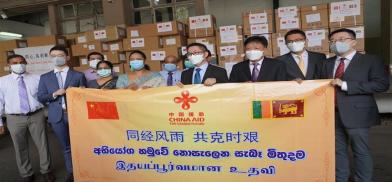Sri Lanka's apparel sector stares at mass unemployment
Many of Sri Lanka’s apparel firms have run out of working capital and credit lines to pay salaries in April and mass unemployment looms as prospects of a quick recovery is also dim with clothes being a discretionary purchase in Coronavirus hit countries, industry officials said

Many of Sri Lanka’s apparel firms have run out of working capital and credit lines to pay salaries in April and mass unemployment looms as prospects of a quick recovery is also dim with clothes being a discretionary purchase in Coronavirus hit countries, industry officials said.
Sri Lanka’s small apparel firms will not be able to pay salaries in April, though some of the bigger firms would be able to manage for one or two months, Ashroff Omar, Chief Executive of Brandix said at an online forum organized by Advocata Institute, a Colombo based think tank.
“I believe there will be intense pressure on prices because we won’t be able to fill capacity, and that will result in several closures,” Omar said.
“So we have been advising the government that they will find massive unemployment starting at the end of April.”
As an industry relying on human capital, almost 70 percent of its overhead costs are generated from its workforce, with factories consisting of 500 as well as 5,000 workers meaning there is not much room to cut costs.
Omar says that apart from the direct stakeholders being impacted, there’s a whole chain of people who provide transport and food services to the factories who also be equally hit.
The industry employs around 400,000 workers and the sector says another two million indirect workers also depend on it.
He says unless an injection is provided for SMEs initially and the rest of the industry in the longer run, survival is bleak without any revenues and a 70 percent cost percent.
“Buyers have requested extended payment terms, some buyers have cancelled orders, pushed back existing orders for next year therefore resulting in a huge cash crunch,” Omar said.
“The bigger companies will be able to pay the basic wage for a couple of months more, but SMEs have given in writing that they have somehow paid March wages, but they won’t be able to pay April wages.”
Cashflows Devastated
Cashflows of most firms have been devastated. Money is tied up in raw materials and half-finished goods, the orders for which have been cancelled in some cases.
Omar says there is a “huge impact on the working capital, primarily there was inventory in form of raw materials, finished product and work-in-progress, everything has just got stuck there.”
Apparel were initially hit by raw material shortfalls after China got Coronavirus, but the worst hit came as orders disappeared with Europe and the US going into lockdown.
Exports in April will be a minuscule of what it was in the same time last year, he said.
“I believe May will be a very rough month for us, June will be tough and hopefully if the rest opens up and the demand picks up maybe from July, August or September,” Omar said.
“But we don’t see a good situation at least up to September. So, it’s very, very, critical and this industry is concerned. Being the largest exporter, it will impact the whole country.”
Sri Lanka exported 341 million dollars’ worth of apparel in April 2019 and achieved the 5 billion export target for the full year.
Buyers had cancelled orders and or requested extended credit period from 30 days to 120-180 days for already exported goods.
“For my companies, right now our priorities are the well-being of our 2500+ people – our greatest asset – many of whom are the sole breadwinners of their family; and to keep our business alive,” Chamila Samarakkodi who heads Design Studio, which has plants in Anuradhapura and Kurunegala, told EconomyNext.
“All manufacturers have paid salaries for the month of March, due on 10th April 2020, by way of collecting all available cash-in-hand at their disposal. Even this required certain pay-cuts to have been made.
“Manufacturers have no means to provide for the remaining timeframe of 6 months at minimum until trading resumes and we are all back in business.
“As such, we request the Government to join hands with us and make arrangements to provide some form of allowance for our employees during this period.”
Shriveling Demand
Sri Lanka’s garment manufacturers are expecting the demand to fall almost 40 percent for the whole year and the demand for next three months until June to shrink about 80 percent.
Apparels predominately being a fashion product is not an urgent requirement, unlike food.
“If you look at the demand, we believe there will be a contraction about 40 percent for the rest of the year but if you look at April,May and June demand will be about 70-80 percent,” Omar said.
Sri Lanka shares about one and half percent of the 40-billion-dollar worth apparel industry worldwide, Omar sid.
Omar said the biggest player China was now well on track while competitors like Bangladesh was in semi-lockdown and Vietnam and Indonesia was still working, there could be a price war.
“So, once the demand shrinks there will be a price war,” Omar said. “In that war because of the customer relationships, because of the products that you supply we will be able to retain some amount of product but it will at prices which will not be attractive at all.
“And if you can break-even you will be lucky.”
Adapting to demand medical garments
With the indefinite fall in demand for non-essential products while demand for food, agriculture and surgical clothing on the other hand has opened new opportunities, in personal protective equipment (PPE) to fight the virus.
“There is immense pressure on pricing except for people who are involved in PPE area,” said Omar. “So,one change we are trying to do is get into other products such as PPEs which is in demand but again due to the curfew government is trying very hard to relax it but with care.”
However, the industry is still trying to source the raw materials to kick start medical garments.
“Sri Lanka’s apparel industry flexibility to switch its production line to produce medical garments and PPE suites is hindered by the unavailability of raw materials in the country,” reiterated Omar.
“Already, many companies have started supplying but the problem is raw materials which still comes from China we have got a couple of our fabricunits to come put with products.
“Sri Lanka’s Export Development Board is also pushing to open factories and resume operations as soon as possible in low risk areas.”
Factories have to operate under strict processes for production and transport.
“The standard operating procedure (SOP) for operations are very very strict,” Omar said.
“There should be social distancing, in transport buses there should be 1 person per seat,etc., so once you do all that what will be your cost, what will be your output and how many can you accommodate in a particular place?”
“So those are the challenges the industry is facing. We will go through a tough time from next to 6 to 8 months and in the short term it will not be a walk in the park.” (EconomyNext)
https://economynext.com/sri-lanka-apparel-sector-face-mass-unemployment-firms-run-out-of-cash-67249/









Post a Comment